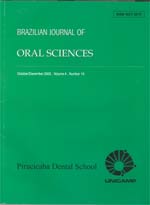
|
Brazilian Journal of Oral Sciences
Piracicaba Dental School - UNICAMP
EISSN:
Vol. 12, No. 4, 2014, pp. 319-322
|
 Bioline Code: os13053
Bioline Code: os13053
Full paper language: English
Document type: Research Article
Document available free of charge
|
|
|
Brazilian Journal of Oral Sciences, Vol. 12, No. 4, 2014, pp. 319-322
| en |
Effects of zirconia nanoparticles addition to experimental adhesives on radiopacity and microhardness
Martins, Gislaine Cristine; Meier, Marcia Margarete; Loguercio, Alessandro Dourado; Cecchin, Fabielle; Gomes, Osnara Maria Mongruel & Reis, Alessandra
Abstract
Aim: To evaluate the radiopacity and microhardness (KHN) of experimental dental adhesives
(EX). The experimental adhesive resins of the present study were formulated based on the
simplified adhesive system Ambar (FGM). Methods: Five EX with different concentrations of
zirconia nanoparticles [0(EX0), 15(EX15), 25(EX25), 30(EX30) e 50%(EX50)] were incorporated
in a UDMA/HEMA adhesive (control). Adper Single BondTM 2 (SB, 3M ESPE) was used as a
commercial reference. For the radiopacity (n=5), KHN (n=5), adhesive specimens were fabricated
using a stainless steel mold. Data were submitted to one-way ANOVA and Tukey´s test (α=0.05).
Results: The filler addition on the EX showed radiopacity similar to enamel and higher than SB.
The EX25, EX35 and EX50 showed higher KHN values when compared to the commercial SB.
EX25, EX35 and EX50 showed higher KHN values when compared to the commercial SB.
Conclusions: The results of the present investigation suggest that the addition of zirconia
nanoparticles seems to be a good alternative to produce radiopaque adhesives with increased
microhardness.
Keywords
radiology; contrast media; nanoparticles
|
| |
© Copyright 2013 - Brazilian Journal of Oral Sciences
Alternative site location: http://www.fop.unicamp.br/brjorals
|
|
